
Cabernet Sauvignon is one of the world's most widely recognized red wine grape varieties. It is grown in nearly every major wine producing country among a diverse spectrum of climates from Australia and British Columbia, Canada to Lebanon's Beqaa Valley. Cabernet Sauvignon became internationally recognized through its prominence in Bordeaux wines where it is often blended with Merlot and Cabernet Franc. From France and Spain, the grape spread across Europe and to the New World where it found new homes in places like California's Santa Cruz Mountains, Paso Robles, Napa Valley, New Zealand's Hawke's Bay, South Africa's Stellenbosch region, Australia's Margaret River, McLaren Vale and Coonawarra regions, and Chile's Maipo Valley and Colchagua. For most of the 20th century, it was the world's most widely planted premium red wine grape until it was surpassed by Merlot in the 1990s. However, by 2015, Cabernet Sauvignon had once again become the most widely planted wine grape, with a total of 341,000 hectares (3,410 km2) under vine worldwide.

Sauvignon blanc is a green-skinned grape variety that originates from the Bordeaux region of France. The grape most likely gets its name from the French words sauvage ("wild") and blanc ("white") due to its early origins as an indigenous grape in South West France. It is possibly a descendant of Savagnin. Sauvignon blanc is planted in many of the world's wine regions, producing a crisp, dry, and refreshing white varietal wine. The grape is also a component of the famous dessert wines from Sauternes and Barsac. Sauvignon blanc is widely cultivated in France, Chile, Romania, Canada, Australia, New Zealand, South Africa, Bulgaria, the states of Oregon, Washington, and California in the US. Some New World Sauvignon blancs, particularly from California, may also be called "Fumé Blanc", a marketing term coined by Robert Mondavi in reference to Pouilly-Fumé.

Chenin blanc is a White wine grape variety from the Loire Valley of France. Its high acidity means it can be used to make everything from sparkling wines to well-balanced dessert wines, although it can produce very bland, neutral wines if the vine's natural vigor is not controlled. Outside the Loire it is found in most of the New World wine regions; it is the most widely planted variety in South Africa, where it was historically also known as Steen. The grape may have been one of the first to be grown in South Africa by Jan van Riebeeck in 1655, or it may have come to that country with Huguenots fleeing France after the revocation of the Edict of Nantes in 1685. Chenin blanc was often misidentified in Australia as well, so tracing its early history in the country is not easy. It may have been introduced in James Busby's collection of 1832, but C. Waterhouse was growing Steen at Highercombe in Houghton, South Australia, by 1862.

White wine is a wine that is fermented without skin contact. The colour can be straw-yellow, yellow-green, or yellow-gold. It is produced by the alcoholic fermentation of the non-coloured pulp of grapes, which may have a skin of any colour. White wine has existed for at least 4000 years.

An aroma compound, also known as an odorant, aroma, fragrance or flavor, is a chemical compound that has a smell or odor. For an individual chemical or class of chemical compounds to impart a smell or fragrance, it must be sufficiently volatile for transmission via the air to the olfactory system in the upper part of the nose. As examples, various fragrant fruits have diverse aroma compounds, particularly strawberries which are commercially cultivated to have appealing aromas, and contain several hundred aroma compounds.
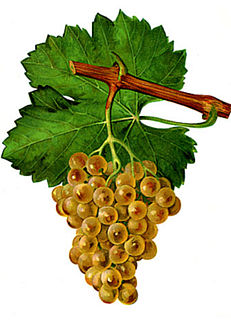
Sémillon is a golden-skinned grape used to make dry and sweet white wines, mostly in France and Australia. Its thin skin and susceptibility to botrytis make it dominate the sweet wine region Sauternes AOC and Barsac AOC.
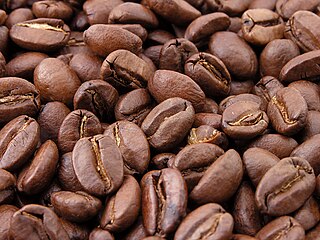
A coffee bean is a seed of the Coffea plant and the source for coffee. It is the pip inside the red or purple fruit often referred to as a cherry. Just like ordinary cherries, the coffee fruit is also a so-called stone fruit. Even though the coffee beans are not technically beans, they are referred to as such because of their resemblance to true beans. The fruits; cherries or berries, most commonly contain two stones with their flat sides together. A small percentage of cherries contain a single seed, instead of the usual two. This is called a "peaberry". The peaberry occurs only between 10% and 15% of the time, and it is a fairly common belief that they have more flavour than normal coffee beans. Like Brazil nuts and white rice, coffee beans consist mostly of endosperm.
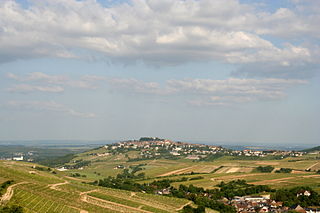
Sancerre is a French wine Appellation d'origine contrôlée (AOC) for wine produced in the area of Sancerre in the eastern part of the Loire valley, southeast of Orléans. Almost all of the appellation lies on the left bank of the Loire, opposite Pouilly-Fumé. It is well regarded for and primarily associated with Sauvignon blanc. Some Pinot noir is also grown, accounting for around 20% of the region's production, making mostly light red wines under the designation of Sancerre Rouge. A rosé style from Pinot noir is also produced in a style similar to Beaujolais, which is produced from the Gamay grape.

5-MeO-MiPT is a psychedelic and hallucinogenic drug, used by some as an entheogen. It has structural and pharmacodynamic properties similar to the drugs 5-MeO-DiPT, DiPT, and MiPT. It is commonly used as a "substitute" for 5-MeO-DiPT because of the very similar structure and effects.

Coffea canephora is a species of coffee that has its origins in central and western sub-Saharan Africa. It is a species of flowering plant in the family Rubiaceae. Though widely known as Coffea robusta, the plant is scientifically identified as Coffea canephora, which has two main varieties, robusta and nganda.
A wine fault or defect is an unpleasant characteristic of a wine often resulting from poor winemaking practices or storage conditions, and leading to wine spoilage. Many of the compounds that cause wine faults are already naturally present in wine but at insufficient concentrations to be of issue. In fact, depending on perception, these concentrations may impart positive characters to the wine. However, when the concentration of these compounds greatly exceeds the sensory threshold, they replace or obscure the flavors and aromas that the wine should be expressing. Ultimately the quality of the wine is reduced, making it less appealing and sometimes undrinkable.
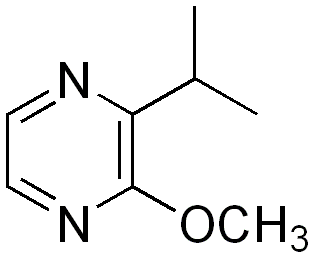
Methoxypyrazines are a class of chemical compounds that produce odors. The odors tend to be undesirable, as in the case of certain wines, or as defensive chemicals used by insects such as Harmonia axyridis which produces isopropyl methoxy pyrazine (IPMP). They have also been identified as additives in cigarette manufacture. Detection thresholds are very low, typically near 2 parts per trillion (1 ng/L).
Ann C. Noble is a sensory chemist and retired professor from the University of California, Davis. During her time at the UC Davis Department of Viticulture and Enology, Noble invented the "Aroma Wheel" which is credited with enhancing the public understanding of wine tasting and terminology. At the time of her hiring at UC Davis in 1974, Noble was the first woman hired as a faculty member of the Viticulture department. Noble retired from Davis in 2002 and in 2003 was named Emeritus Professor of Enology. Since retirement she has participated as a judge in the San Francisco Chronicle Wine Competition.
Alkylpyrazines are chemical compounds based on pyrazine with different substitution patterns. Some alkylpyrazines are naturally occurring highly aromatic substances which often have a very low odor threshold and contribute to the taste and aroma of various foods including cocoa, baked goods, coffee and wines. Alkylpyrazines are also formed during the cooking of some foods via Maillard reactions.

The aromas of wine are more diverse than its flavors. The human tongue is limited to the primary tastes perceived by taste receptors on the tongue – sourness, bitterness, saltiness, sweetness and savoriness. The wide array of fruit, earthy, leathery, floral, herbal, mineral, and woodsy flavor present in wine are derived from aroma notes sensed by the olfactory bulb. In wine tasting, wine is sometimes smelled before taking a sip in order to identify some components of the wine that may be present. Different terms are used to describe what is being smelled. The most basic term is aroma which generally refers to a "pleasant" smell as opposed to odor which refers to an unpleasant smell or possible wine fault. The term aroma may be further distinguished from bouquet which generally refers to the smells that arise from the chemical reactions of fermentation and aging of the wine.
This glossary of viticultural terms list some of terms and definitions involved in growing grapes for use in winemaking.
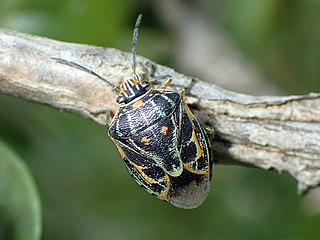
Antestiopsis is a genus of shield bug, commonly known as antestia and the variegated coffee bug. Several species in eastern Africa are pests of coffee plants, giving the coffee beans a distinctive 'potato taste', which is thought to be caused indirectly by bacteria entering through wounds created by the insects, leading to an increase in the concentration of isopropyl methoxy pyrazine. They feed on flowers, berries and growing tips, injecting a toxic saliva that often contains the spores of the Ashbya fungus, and then suck juices out.
Cabernet blanc is a white German and Swiss wine grape variety that is a crossing of the French wine grape Cabernet Sauvignon and Regent. The grape was bred by Swiss grape breeder Valentin Blattner in 1991. Cabernet blanc has strong resistance to most grape disease including botrytis bunch rot, downy and powdery mildew and tends to produce loose clusters of small, thick-skinned grape berries which can hang on the vine late into the harvest season to produce dessert wines. Today the grape is found primarily in the Palatinate wine region of Germany with some experimental plantings in Spain and the Netherlands. In France, in the Languedoc, Domaine La Colombette is heavily investing in PIWI grapes. Amongst others the Cabernet Blanc in their cuvée "Au Creux du Nid", is gaining wide acclaim.

3-Isobutyl-2-methoxypyrazine is a methoxypyrazine that is very similar to isopropyl methoxy pyrazine except that the alkyl side-group contains an isobutyl group attached to the carbon alpha to the methoxy sidegroup instead of an isopropyl side-group at that same carbon position.















